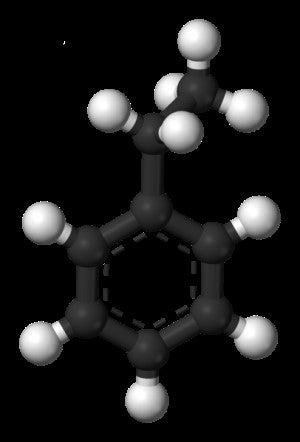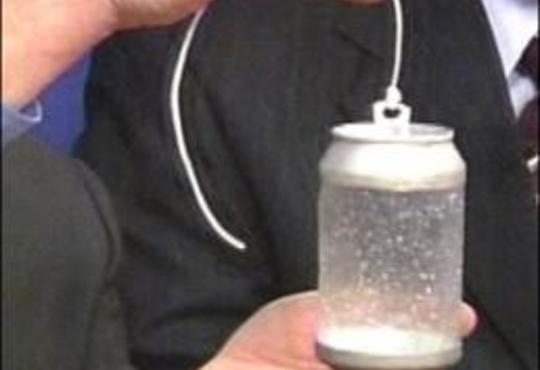As chemical educators, we are always thinking of potential hazards in the chemistry laboratory. But it is easy to overlook potential hazards elsewhere in our lives and in the lives of our students. A specific example is the toxicity of substituted benzenes, in particular, ethylbenzene (Fig. 1) and the three structural isomers of dimethylbenzene (commonly called xylenes or under the trade name of xylol). Here I will recount first my personal experience, and then how recently, I became aware of a more widespread incident. This saga might be useful to include in discussions with your students on chemical toxicity.
My own exposure occurred as follows. I was residing in a condo in which the vinyl flooring throughout the kitchen and dining area was being replaced. During that time, I was sitting at my desk in the neighbouring room. The flooring was poorly-installed and the manager of the installation company agreed that, at their expense, they would remove the new vinyl and replace it. Again, I was working nearby while the second installation was performed. That evening, I drove out to shop, and as I did, I realized that I was weaving across the lanes of the highway. It took every effort to try to keep fairly straight. At the shopping complex, I found parking within the lines of a parking bay, a very challenging task.
The next morning, I went for a walk with friends. I was feeling somewhat light-headed but then I suddenly passed out, falling on the sidewalk. Awakening in a hospital examination room.
I gathered subsequently that I had been given a spinal tap, an EEG, an EKG, and later an MRI. After two days, I was discharged though I was still dizzy, my hands shook as I tried to write, I had severe headaches, and I vomited my food. The medical specialist decided that I had experienced a brain seizure and prescribed life-long barbiturates. A friend informed me of the severe side-effects of barbiturates — especially life-long consumption — and I decided to ignore the recommended pharmaceutical. I found that the dizziness was worse in the mornings and that, with walking, by each evening I felt much better.
I suspected that it had not been a brain seizure, but that it had been exposure to the solvents used for the vinyl glue that was the culprit. In support of my belief, the label on the glue container left by the installers noted that it contained aromatic hydrocarbons and that it was very hazardous, and not to be used in a confined space. Returning to Corner Brook, I was given an alternative diagnosis of poisoning by inhalation of toxic substances. The physician to whom I was referred had worked previously with glue sniffers, and he noted that my symptoms matched with that diagnosis. He advised me to continue with as much exercise as possible and within three weeks I was back to normal. Apparently, being non-polar molecules, the glue vapours had been absorbed throughout my fatty tissues. Exercise caused a proportion to be expelled through the blood and then lungs. However, at night, the remaining molecules would redistribute themselves around my body and, in particular, re-equilibrate with the brain concentration.
That was about 10 years ago. In October 2013, at the institution where I work, a memo was circulated that the new gymnasium floor was being sealed and varnished, and that a smell might be apparent. The memo implied that the ‘smell’ was innocuous. Suspicious of such a claim, I was able to obtain the MSDS sheet for the material (Buckeye Coliseum 100) and it immediately became apparent that included in the solvents were the same which I had experienced — the dimethylbenzenes (xylenes) and ethylbenzene.

Fig. 1:The ball-and-stick representation of ethylbenzene (from: http://en.wikipedia.org/wiki/File:Ethylbenzene-3D-balls.png).
A portion of the MSDS sheet is shown in Fig. 2. I warned the administration, and precautions were hastily put in place, including vapour monitoring.

Fig. 2 Section from Materials Safety Data Sheet (MSDS) for Buckeye Coliseum 100.
The gymnasium and swimming pool is an integral part of the Arts & Science building of the campus. Despite the precautions, the monitoring showed total volatile organic compounds (VOCs) levels in excess of 100 ppm had permeated through many parts of the building. Unfortunately, the monitoring company did not have the means of testing for individual compounds. With the VOC levels increasing, the building was closed for a short period until levels could be reduced by temporary additional fan ventilation. In terms of air exchange, the gymnasium was theoretically isolated from the remainder of the complex. However, unaware of the situation, over the ensuing week, staff and faculty in offices located near to the gymnasium began to experience severe headaches, inability to focus on their work, and, in some cases, reported mental confusion which they described as “like being stoned”. The symptoms clearly matched those corresponding with exposure to significant levels of these same compounds, which in some manner must have vented into their part of the building. Though some people are more sensitive to inhaled vapours than others, the generality of the symptoms of mental disorientation would, according to safety information (references below), suggest that significant levels had been experienced.
This narrative, then, is designed to heighten awareness amongst chemical educators of the hazards of solvents in the workplace and at home, particularly these substituted benzenes. It is very troubling to me that the administration had been assured prior to the contractors undertaking the work that the substances were ‘harmless’ and that they had been used in many other locations ‘without incident’ — though one must question the veracity of that last statement. One wonders how many people at such locations had experienced symptoms of poisoning but had never linked severe headaches, dizziness, and so on, to any exposure to substituted benzenes and instead blamed it on a virus infection — or, as in my case, had the symptoms diagnosed as a ‘mild brain seizure.’
From a quick on-line review, many organic solvent mixtures contain dimethylbenzenes and ethylbenzene. Thus you should urge your students to review MSDSs not only for chemicals used in the laboratory setting, but also for solvents used at home. Though the MSDSs are the required documentation, the United States Department of Labor OSHA summaries are particularly informative. In particular, for each compound, below the Table of Exposure Limits and Health Effects you can find the Agency for Toxic Substances and Disease Registry (ATSDR) Inhalation Minimal Risk Level (MRL) values. It is these numbers — which are much lower than the Limit Values — which provide true perspective of the hazard. So for dimethylbenzene, the short-term (acute) exposure limit is 2 ppm, the intermediate-length exposure limit is 0.6 ppm, and the long-term (chronic) exposure limit is 0.05 ppm. The parallel figures for ethylbenzene are 5 ppm, 2 ppm, and 0.06 ppm. The Department of Labor pages on these compounds are:
- https://www.osha.gov/dts/chemicalsampling/data/CH_276400.html
- https://www.osha.gov/dts/chemicalsampling/data/CH_240000.html
Additional information on the ATSDR-MRL values can be found at:
The following websites are additional reputable sources of information about the hazards of these materials, which seem to be much more documented for the dimethylbenzene isomers than for ethylbenzene:
- http://www.ccohs.ca/oshanswers/chemicals/chem_profiles/xylene.html
- http://www.hc-sc.gc.ca/ewh-semt/pubs/contaminants/ethylbenzene-eng.php
- https://www.ncbi.nlm.nih.gov/pmc/articles/PMC2996004/
- http://www.cdph.ca.gov/programs/hesis/Documents/xylene.pdf
An article from the Western Star, the newspaper for western Newfoundland describes the incident at Grenfell Campus.
I would welcome hearing of the experiences of anyone else who has had encounters with these compounds.







